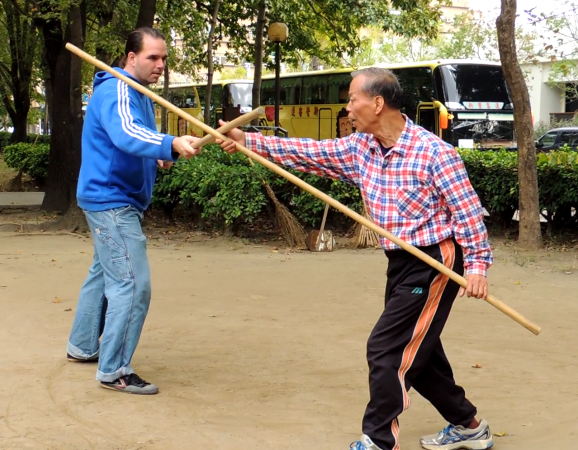I was reading an article online the other day and there was a sentence that struck me. It said something like- there is a tendency to define martial arts on how they are unique or what sets them apart from other styles rather then how they are similar. This got me thinking, first- that is very true, and second martial arts are more similar then they are dissimilar. So I thought that this would make a good topic for a blog post. Now keep in mind these are just some thoughts on the topic and not a thesis or even a complete evaluation of the subject.
How to Deal with an Opponent
- Blocking
- Mobility
- Attacking
Scope of Training
- Skill Development
- Power Development
- Sensitivity or 2 Person Work

Master Lin Miaohua and Franklin Fick practicing Taiji Quan 2 Person Staff Work. Taiwan
How to Deal With an Opponent
First, all martial arts are about surviving physical encounters. Now each style might emphasize a different range of combat or prefer certain tactics, but the goal remains the same- to survive. All arts must train dealing with incoming force, mobility, and attacking.
Blocking
Lets talk about dealing with incoming force. All arts have to deal with incoming force, otherwise there would be nothing to survive. Lets talk about dealing with incoming force by blocking. We will talk about evading under mobility.
When a force is coming in we can either get out of the way (mobility) or we can block the force. This is usually done by one of two methods. We can intercept and cut through the incoming force or we can transform it. Cutting through it is pretty self explanatory, you just cut through it, moving the attack away from its target or stopping the force. Transforming is following the force and while following it, adjusting its trajectory.
Mobility
All arts also train mobility. Moving in, retreating, and evading or lateral movements. This is accomplished through the stances, stepping, and footwork combined with the body movements.
Attacking
All arts also train attacking in some manner. This can be through striking, locking (chin-na), or throwing. Throwing can be any sort of take-downs and sweeps. Joint locking is manipulating the joints. Striking is using parts of the body such as the fists, palms, elbows, feet, knees, shoulder, and hips to strike the opponent.
Scope of Training
Training in most styles involves three different areas of development: skill development, power development, and sensitivity/partner training.
Skill Development
Skill development is just that, developing certain skills. These skills can be striking, footwork, blocks, etc. This is usually accomplished through drilling short movements or forms.
Power Development
Power development is just that, exercises or drills for developing power. These practices can focus on many different things depending on the art. Sometimes skill and power development are intertwined and overlap, and sometimes power development exercises do not look anything like the skills the power will be used in. Power exercises can focus on muscular development- something as basic as a pushup or much more subtle in some of the Chinese internal arts of Kung Fu. Power development can also focus on coordination and connection.
Ways to Generate Power
The main components or power for striking that exist in many different styles are:
- rotation around the central axis
- pushing form the ground
- dropping into the ground
- whipping the power from the center
Sensitivity or 2 Person Work
All these components are usually integrated into two person work. This can take the shape of sensitivity drills, reaction, timing, mobility, and response training, etc.
Going beyond these basic things all arts have strategies that are trained. Like how to continuously attack, how to lead the attacker, how to bait the attacker, how to use the attackers force, etc. These are usually all part of the advanced two person training.
So in general- all arts have these components. Broken down like this it is easy to see how all arts are more similar then they are different. Of course the details are different in different arts, but the similarities far outweigh the differences.






